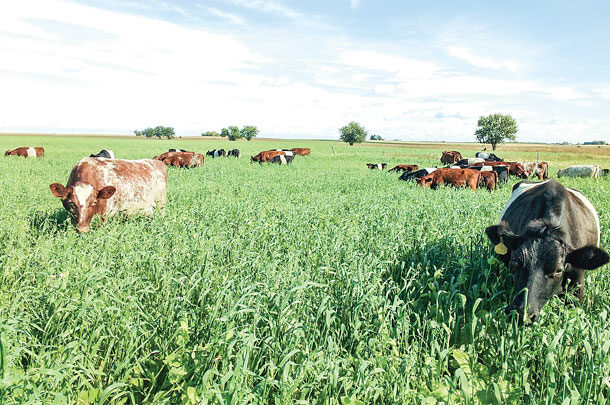Cover crops can provide many benefits to producers, from forage value to soil health improvements and beyond. With many species to choose from, it can sometimes be a challenge to know where to start. This is where cover crop calculators can be a valuable tool to help producers learn about and pick species that will meet goals and be successful in their environment.
Some calculators can be useful for specific aspects of cover crop use, like Oregon State University Extension’s calculator that estimates the fertilizer value of cover crops and compares the cost to purchased fertilizers. Iowa Learning Farms has a spreadsheet tool that compares cover crop costs, taking into account seed and termination costs for different mixes and species.
Other calculators take information like intended uses, planting dates and other variables that go into choosing the right cover crop mix for a producer’s particular application. There are different free options, like Millborn Seeds’ My SeedMix website and smartphone app that recommends a list of potential species after inputting planting method, time of year, and primary and secondary goals. From there, producers can choose from those species based on pricing and seeding rate.
SmartMix is a free online calculator developed by Green Cover Seed that goes into more depth. It takes geographic location, planting date, following crop and other data into consideration, along with the goal of the cover crop to suggest potential options for the producer.
Keith Berns, co-owner and sales manager at Green Cover Seed, developed the calculator as a spreadsheet for use within the company, but almost a decade ago, he put it on their website for everyone to use and has updated it to incorporate more information and detail.
Today, it shows users the price of their mix, carbon-to-nitrogen ratios, nitrogen fixing ratios and other data to allow fine-tuning for maximum benefit and efficiency. Videos and tech sheets allow producers to learn about the different cover crop species to help decide between the options.
“It’s not going to build the mix for you, but it will help you sort out choices,” Berns explained.
Berns said some people will spend time tweaking the mix by testing things like how different planting and termination times change the prediction of the success of their different goals.
“People can dial that mix in to where they want it to be,” he said.
After creating a mix, producers can talk with a Green Cover Seed representative and get advice before finalizing an order, but many people use the calculator without buying seed from that particular company.
Berns said the main challenge people have when they use the calculator is narrowing down to what the main goals are for the cover crop, since targeting a particular primary and a few secondary goals is vital.
Michael Neff of Kansas is a producer who has been using the calculator for years to put together his cover crop mixes.
“It’s been so handy and convenient,” he said. “I like it for the fact that I can tailor it to my environment and my needs.”
He likes being able to work on mixes on his own at any time of day before he talks with a salesman to finalize his order.
“It’s just a great tool to use education wise too,” he said.
Using the calculator has also made him more aware of the things he is trying to accomplish with his crops, livestock, and soil health and has given him more knowledge to use to further his goals.
However, one potential challenge is getting started using the calculator.
“Everybody has their own different comfort zone with technology,” Neff said but added, “It’s relatively easy to use.”
Additionally, he recommends first-time cover croppers go beyond the calculator to talk with a cover crop seed salesman and a local agronomist or farmer who has experience using cover crops to learn more and get an idea of what works locally.
Luke Adams, president of AgriTerre Seed LLC, also emphasizes the importance of working with a cover crop expert even if a producer uses a cover crop calculator of some sort.
Adams accounts for the nuts and bolts of a producer’s operation adding cover crops in a way a calculator cannot accomplish.
“I spend far less time worrying about balancing carbon and way more worrying about practical farming,” he said.
These practical aspects include what type of tillage a farmer wants to use before or after a cover crop and how much and what kind of residue the farmer wants the cover crop to leave behind.
Working with customers to collaboratively build a successful mix is Adams’ goal, whether they use a calculator before they talk with him or not.
“With a more personalized approach, we avoid placing non-appropriate species and maybe avoid issues that a calculator may recommend,” he said.
He sees the calculators as a valuable starting point that needs to be followed by sitting down with a person who will learn details like the producer’s goals, local needs and particular crop rotation. This can help avoid potential issues like a cover crop hosting a harmful pest for a following cash crop or the producer using a species unsuited to a particular soil type, temperature and elevation that may not be accounted for in a calculator.








